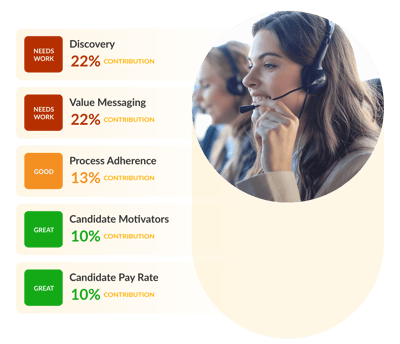1 min read
Most Staffing Firms are Not Built to Scale, But to Survive
Most staffing firms don’t struggle to scale because their teams aren’t working hard. They struggle because they don’t have a real go-to-market...
5 min read
![]() Dan Fisher
:
Dec 20, 2022 9:14:10 AM
Dan Fisher
:
Dec 20, 2022 9:14:10 AM

If the impact of your sales and recruiter training initiatives are disappointing, it is likely because your program or programs don’t go far enough. Sales training and recruiter training is ideal for onboarding new hires and giving them the basic knowledge they need to perform their job. This includes teaching them their job function, role and responsibilities, company history and service offerings. But on its own, training doesn’t move the revenue needle.
More and more organizations are recognizing this and are transitioning from traditional training (classroom, shadow, webinars) to enablement. According to CSO Insights, over 60% of surveyed companies currently have a formal enablement program. Another 25% plan to start one in the upcoming year. 
To better understand this trend and why so many organizations are abandoning traditional training for enablement, I'm going to highlight the key differences between sales enablement and sales training. I'm also offering this free resource, The Staffing Leaders Guide to Sales Enablement. The guide serves as a roadmap for industry leaders seeking to transition away from traditional training and implement a formal enablement function.
If you are new to sales enablement than check out my related article, Understanding the Role, Value of Sales Enablement in a Digital World
Training Was Never Designed to Support Learners in Adopting New Behaviors
The role and purpose of training is simply to communicate and impart knowledge. To 'impart knowledge' or to 'impart information', means to pass on, transmit or communicate information or understanding about a topic to another person or group. While training, and imparting information on behalf of sellers and recruiters is critical to their development, it falls well short of what they need to consistently perform. Why? Because recruiters and salespeople have very unique training needs.
The objective of any sales training or recruiter program is to change behavior. But you can’t change behavior by simply communicating facts and sharing knowledge.
Think about attending a workshop, webinar, conference, or any other live, instructor-led training. You sit in a room and a facilitator, usually a trainer or company leader, presents information. The facilitator talks and the audience listens (sure, they may do some exercises). Key points are presented and discussed but adopting and applying the knowledge in the field is 100% left up to each individual learner. The same is true with reading a book, or a corporate training manual.
Training was never designed to support learners in adopting training material in the field or on the job. Training was never designed to foster new skills and behaviors such as how to project confidence, demonstrate credibility, disarm a candidate or prospect, or ask timely discovery questions.
Training is Tactical
Part of what makes training tactical is the fact that it is event-oriented, and managed as as project with a start date and an end date. The objective with training is time to completion. There is nothing about training that is sustainable, scalable, or repeatable.
Below are a few of the common attributes and behaviors that minimize training to a tactical, ancillary task.Training is Synonymous (and still relies on) LMS or Learning Management System
Many staffing organizations have moved their training content online to an LMS or Learning Management System or online shared drive. While making training content available for consumption online is a move in the right direction, traditional LMS lack the capability and functionality to support the unique training needs of recruiters and sellers.
As I discuss in my blog post, Why You Can't Train Your Sales and Recruiting Team With an LMS, Learning Management Systems were never designed to drive behavioral change. An LMS is essentially an online respository designed to store, manage and administer training content. LMS's were designed to support Training Managers, not the individuals consuming the training!
Related: The Difference Between Sales Enablement Software and LMS
Training Leaves Leaders in the Dark Regarding ROI
With training you can track attendance of those who attended a workshop, presentation, or webinar but you can’t track and measure field adoption. You can’t track and measure the frequency and effectiveness in which a learner is applying the training material on their sales calls or in candidate interviews. You can't track learner competency and tie it back to field results.
This leaves leaders in the dark regarding training ROI and makes them skeptical of investing in future training initiatives.
The Bottom Line with Training
Training still plays a very important role in the development of your salespeople and recruiters. But at the end of the day, training is just one element of the overall enablement solution that an organization needs to be adopting.
Enablement is Strategic
Enablement is outcome oriented and designed to make winning behaviors repeatable and scalable. The objective is to increase predictable sales results. But achieving this requires a different approach to how you run and manage your enablement programs.
Unlike training, enablement is managed as a strategic revenue generating discipline that is set apart from other functions such as finance, marketing, or operations. Much like a CFO manages a finance department or a CIO manages an IT department, enablement is managed as a separate, strategic discipline with its own KPI's, governance model, and is accountable for revenue growth. Organizations live and die based on the success of their sales and delivery (recruiting) organizations, so it only makes sense that enabling them be treated as a top priority.
Second, enablement includes a formal enablement charter. Your enablement charter functions as your business plan and is your guide for turning random training events into a formal, scalable, and strategic enablement discipline that has a quantifiable impact on the business.
Your charter also specifies how your enablement services aligns with and supports the business strategy and sales strategy. For example, if the goal of your organization is to expand by opening new offices in new markets, your enablement charter spells out how it supports this strategy.
Your charter is how you (training managers) get buy-in and funding from your C-suite.
Collaboration is Key to Success, Core Value of Enablement
Previously I mentioned that enablement is managed as a separate, revenue generating discipline that is set apart from other functions such as finance or marketing. But this does not mean that all enablement services are created and delivered in a vacuum. In fact, to make a quantifiable impact, you must have effective collaboration.
It is through collaboration that enablement services get created, delivered, and most important of all, adopted. Enablement is a collaborative effort and the primary role of enablement leaders is to orchestrate the efforts of others to create and deliver consistent and effective enablement services.
But for many organizations, collaboration simply means "keeping others in the loop." Organizations with a more formal approach to collaboration are as much as 21% better at achieving quota than organizations with no approach or an ad-hoc approach to collaboration.
Sales enablement, unlike training, includes a formalized approach to collaboration. To learn more about formalized collaboration, check out my blog post, Formalized Collaboration, RACI Model Key for L&D Making an Impact
Enablement is Consistent, Continuous and Ongoing
Humans forget approximately 50 percent of new information they encounter within an hour and an average of 70 percent within 24 hours, cognitive science expert Art Kohn notes. After a week, he says, that average goes up to 90 percent.
There are plenty of other studies (Google "memory retention statstics") that support similar findings. So it doesn't take a rocket scientist to figure out that for training to stick and have a lasing impact, there needs to be continuous, ongoing reinforcement. Not only that, markets evolve, bad behaviors creep back into play, new competitors arrive, and sales strategy and business goals change. As such, salespeople and recruiters must be consistently enabled with the skills and knowledge in order to adapt and thrive.
See my related blog post: Spaced Reinforcement Key to Learner Retention
With Enablement and Enablement Software You Can Track, Measure Learner Comptency
With enablement and enablement software, you can define your most important sales and recruiting skills, comptencies, and winning behaviors and assign a weighted value to each. With weighted values you can then set benchmarks for top rep and recruiter performance build your training exercises around those competencies.
To learn more about sales enablement and how to build a world class sales enablement function for your organization, download our ebook, The Staffing Leaders Guide to Sales Enablement

1 min read
Most staffing firms don’t struggle to scale because their teams aren’t working hard. They struggle because they don’t have a real go-to-market...

In my previous post, How to Prevent Unexpected Contract Terminations, I shared how systemizing consultant and client check-ins at key milestones...

About a year ago, I was serving as the fractional revenue leader, managing sales and recruiting for a client.